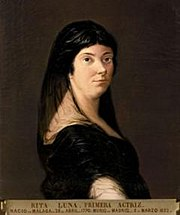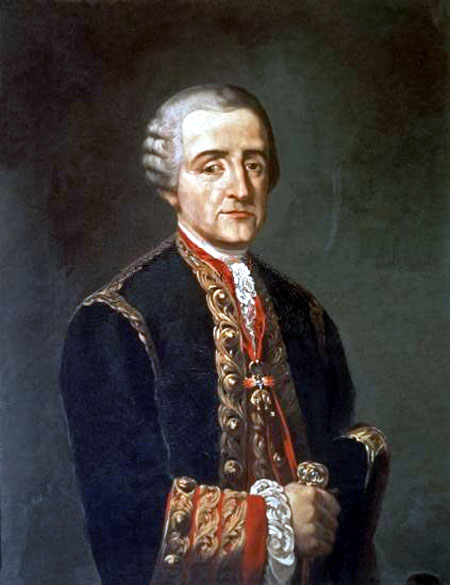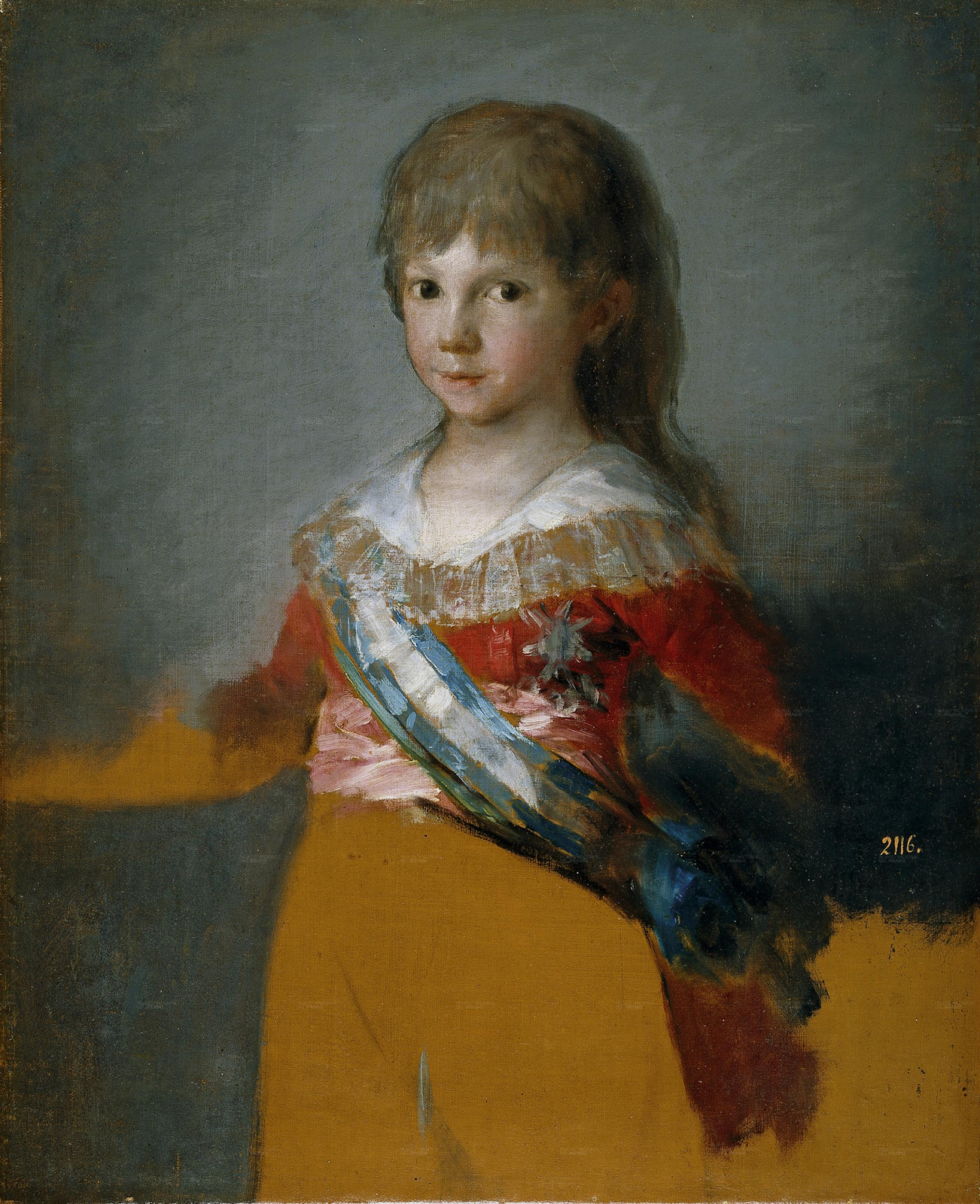The book starts with a prologue which mentions Goya's painting 'The family of Carlos IV'. This portrait was painted in Aranjuez and Madrid in the spring and summer of 1800, shortly after Goya was named First Chamber Painter. The scene is presided over by Queen María Luisa de Parma and King Carlos IV, at the center. Beside them are their children, the infante Francisco de Paula and the infanta María Isabel. On the left are the Prince of Asturias and future Fernando VII; the infante Carlos María de Isidro, who was second in succession to the throne; the infanta María Josefa, who was the King´s sister; and an unidentified young woman. On the right are the infante Antonio Pascual, the King´s brother; a rendering in profile of Carlota Joaquina, Queen of Portugal and eldest daughter of the Monarchs and the Prince and Princess of Parma: infanta María Luisa, holding her son Carlos Luis; and her husband, Luis de Bourbon, the future King of Etruria.
Gabriel is working for an actress, Pepita González, and he mentions several actresses from the period.
María del Rosario Fernández (1755–1803), was a Spanish stage actress. She is regarded as one of the most notable stage actors of Spain during her period, and was known as La Tirana.
Rita Luna (1770–1832), was a Spanish stage actress. She is regarded as the leading female stage actor of the Spanish stage of her time.
María Antonia Vallejo Fernández (9 March 1751 – 10 June 1787), also known as La Caramba, was a Spanish singer and dancer of tonadilla music.
Antonia de Prado (1765 — Madrid, 1830) was an actress in the 18th and 19th century in Spain. He was the wife of Isidoro Máiquez. Isidoro is a main character in this novel. Isidoro Máiquez (Cartagena, 17 March 1768-Granada, 18 Marchde 1820) was a Spanish actor in the 18th and 19th centuries. He was considered one of the best actors of his time.
Pepita is part of Maiquez's company at the Teatro del Príncipe. El Teatro del Príncipe was a theatre in the sixteenth, seventeenth, eighteenth and nineteenth centuries. It was destroyed by a fire in 1802 and it had to be rebuilt. Later in 1849 this theatre became the current 'Teatro Español', the only theatre in Madrid which was an old corral de comedias.
Gabriel goes to see 'El sí de las niñas' by Leandro Fernández de Moratín, who his employee, Pepita, detested, and he was ordered to heckle the play. Leandro Fernández de Moratín (10 March 1760 – 21 June 1828) was a Spanish dramatist, translator and neoclassical poet. The Maidens' Consent (Spanish: El sí de las niñas) is one of his plays. It was written in 1801 and first performed in 1806. The play is a satirical commentary on Spanish social norms of the time and has since become part of the repertoire.
Gabriel is witness to the conspiracy of 'El Escorial'. The El Escorial Conspiracy was an attempted coup d'état led by the Crown Prince Ferdinand that took place in 1807, but was quickly discovered and led to an investigation known as the Process of El Escorial. The plot was discovered on October 27, 1807 during the royal family's stay at the Monastery of El Escoorail. The El Escorial Conspiracy was an attempted coup d'état led by the Crown Prince Ferdinand that took place in 1807, but was quickly discovered and led to an investigation known as the Process of El Escorial.ecibe.
One of the men involved was Juan de Escoíquiz. Juan Escoiquiz Morata (1762 – 27 November 1820) was a Spanish ecclesiastic, politician and writer. Escoiquiz was selected to be the tutor of the heir-apparent, Ferdinand, afterwards King Ferdinand VII. He had a large share in the El Escorial Conspiracy which was detected on 28 October 1807. He was imprisoned and sent for trial with other conspirators. But as they had appealed to Napoleon, who did not want his name to be mentioned, the government had to allow the matter to be quieted, and the prisoners were acquitted.
In the novel Manuel Godoy is often criticised and everybody seemed to favour Fernando.
Manuel de Godoy y Álvarez de Faria Ríos (12 May 1767, Badajoz – 4 October 1851, Paris), 1st Prince of the Peace, was the First Secretary of State of the Kingdom of Spain from 1792 to 1797 and then from 1801 to 1808, and as such, one of the central Spanish political figures during the rise of Napoleon and his invasion of Spain. Godoy came to power at a young age as the favourite of King Charles IV and Queen Maria Luisa.
Fernando VII (14 October 1784 – 29 September 1833) was King of Spain during the early 19th century. He reigned briefly in 1808 and then again from 1813 to his death in 1833. In his youth Ferdinand occupied the position of an heir apparent who was excluded from any participation in government by his parents and their favourite advisor and Prime Minister, Manuel Godoy. In October 1807, Ferdinand was arrested for his complicity in the El Escorial Conspiracy in which the rebels aimed at securing foreign support from the French Emperor Napoleon. When the conspiracy was discovered, Ferdinand submitted to his parents.
It was rumoured that Napoleon's army was to enter Portugal to divide teh country between the Etruria kings, Francia and Godoy. The Treaty of Fontainebleau was a secret agreement signed on 27 October 1807 in Fontainebleau between King Charles IV of Spain and the French Emperor Napoleon. Under the treaty, the House of Braganza was to be driven from the Kingdom of Portugal with the country subsequently divided into three regions, the north and south to be ruled by Duke of Parma and Spanish minister Manuel Godoy respectively, while the provinces of Beira, Tras-os-Montes and Portuguese Estremadura would remain in abeyance until a later peace. Within seven months the government of Spain had collapsed and two Spanish kings abdicated. In August 1808 Napoleon imposed his brother Joseph as King of Spain.
Gabriel mentions that in 1792 Floridablanca was ousted as Minister. José Moñino y Redondo, 1st Count of Floridablanca (October 21, 1728 – December 30, 1808) was a Spanish statesman. He was the reformist chief minister of King Charles III of Spain, and also served briefly under Charles IV. His centralist policies brought him into conflict with regional interests, and he was often at odds with the Aragonese faction at court, which enjoyed many traditional liberties from the central government. The Aragonese faction, supported by the queen's lover Manuel de Godoy and the Count of Aranda, finally succeeded in ousting Floridablanca from power in 1792 on charges of embezzlement. Floridablanca was imprisoned at the castle of Pamplona for three years and released only after the intervention of his brother. He was acquitted in 1795 although the ordeal weighed heavily upon him, and he retired to seclusion on his estates.
Godoy favoured the Count of Aranda. Pedro Pablo Abarca de Bolea y Jiménez de Urrea, 10th Count of Aranda (1718 in Siétamo, Huesca – 1798 in Épila, Saragossa), was a Spanish statesman and diplomat.
Gabriel also mentions Jovellanos. Gaspar Melchor de Jovellanos (5 January 1744 – 27 November 1811) was a Spanish neoclassical statesman, author, philosopher and a major figure of the Age of Enlightenment in Spain. Melchor de Jovellanos combined with his colleague Saavedra to procure Godoy's dismissal. Godoy returned to power in 1798 and Jovellanos was again sent away to Gijón.
The War of the Oranges was a brief conflict in 1801 in which Spanish forces, instigated by the government of France, and ultimately supported by the French military, invaded Portugal. It was a precursor to the Peninsular Wars, resulting in the Treaty of Badajoz, the loss of Portuguese territory, in particular Olivenza, as well as ultimately setting the stage for the complete invasion of the Iberian Peninsula by French forces.
Gabriel goes to El Escorial at the bequest of Amaranta. El Escorial, or the Royal Site of San Lorenzo de El Escorial is a historical residence of the king of Spain located in the town of San Lorenzo de El Escorial. El Escorial is the largest Renaissance building in the world. It is one of the Spanish royal sites and functions as a monastery, basilica, royal palace, pantheon, library, museum, university, school, and hospital.
There Gabriel comes across members of the Royal Family.
One is Carlos IV. Charles IV (11 November 1748 – 20 January 1819) was King of Spain and ruler of the Spanish Empire from 1788 to 1808. He detested his son and heir Ferdinand, who led the unsuccessful El Escorial Conspiracy and later forced Charles's abdication after the Tumult of Aranjuez in March 1808, along with the ouster of his widely hated first minister Manuel de Godoy.
He overhears a conversation between Amaranta and the Queen María Luisa of Parma. Maria Luisa of Parma (9 December 1751 – 2 January 1819) was, by marriage to King Charles IV of Spain, Queen of Spain from 1788 to 1808 leading up to the Peninsular War. Her relationship with Manuel Godoy and influence over the King made her unpopular among the people and aristocrats.
Infante Francisco de Paula of Spain (10 March 1794 – 13 August 1865) was an Infante of Spain and the youngest son of Charles IV of Spain and Maria Luisa of Parma. He was a brother of Ferdinand VII, and the uncle and father-in-law of Isabella II.
Infante Antonio Pascual Francisco Javier Juan Nepomuceno Aniello Raimundo Silvestre of Spain (31 December 1755 – 20 April 1817) was a son of King Charles III of Spain and younger brother of King Charles IV of Spain and King Ferdinand I of the Two Sicilies. He supported his nephew Prince Ferdinand, Prince of Asturias, and profoundly disliked Manuel Godoy.























No comments:
Post a Comment